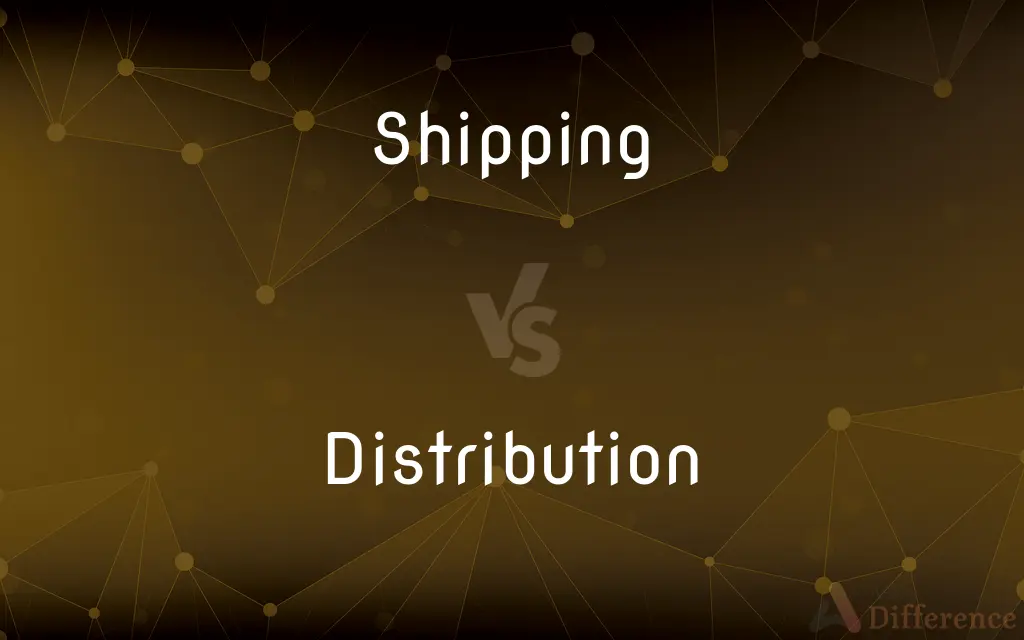Shipping vs. Distribution — What's the Difference?
By Maham Liaqat & Urooj Arif — Updated on March 14, 2024
Shipping involves the physical movement of goods from one location to another, focusing on the logistics of transportation. Distribution, encompasses a broader scope, including storage, inventory management, and the overall strategy for getting products.

Difference Between Shipping and Distribution
Table of Contents
ADVERTISEMENT
Key Differences
Shipping is a key component of the logistics process, primarily concerned with the transportation of goods. It can involve multiple modes of transport, such as road, rail, air, or sea, to move items from the manufacturer to the next point in the supply chain. Distribution, on the other hand, includes not only the transportation of goods but also warehousing, inventory control, order fulfillment, and the planning required to ensure products reach the end consumer efficiently and effectively.
While shipping focuses on the execution of moving goods, distribution strategies are concerned with how to best get products from the manufacturer to the end user. This includes decisions on which channels to use, the locations of warehouses, and how to manage inventory levels. On the other hand, shipping decisions are often about selecting the best carriers, routes, and packaging for transportation.
Distribution networks are designed to optimize the flow of goods from suppliers to customers, incorporating shipping as a key element. These networks consider the most efficient ways to store and handle goods, ensuring timely delivery to the market. In contrast, shipping operations are more tactical, dealing with the immediate requirements of transporting goods safely and on time.
The success of a distribution strategy relies heavily on effective shipping practices. Efficient shipping reduces costs, improves delivery times, and enhances customer satisfaction. Conversely, the broader distribution strategy influences shipping by determining the overall approach to moving goods, including the choice of shipping methods and logistics partners.
In terms of scalability, distribution strategies need to adapt to changes in market demand, product lines, and expansion into new territories. Shipping tactics will then align with these strategies, adjusting to new distribution requirements, such as international regulations or the need for specialized handling.
ADVERTISEMENT
Comparison Chart
Focus
Transportation of goods
Overall strategy to get products to customers
Scope
Limited to movement
Includes transportation, warehousing, inventory management
Strategy
Selection of carriers, routes
Planning of warehousing, inventory, and fulfillment
Operational Concerns
Packaging, routing, carrier selection
Inventory levels, warehouse locations, shipping methods
Impact on Supply Chain
Directly affects transit times and costs
Affects efficiency, costs, and customer satisfaction across the supply chain
Compare with Definitions
Shipping
Involves selecting carriers and arranging logistics.
Our shipping department handles all freight bookings.
Distribution
Manages the supply chain from manufacturer to consumer.
The distribution center serves multiple retail locations.
Shipping
Can be international or domestic.
International shipping requires understanding of customs regulations.
Distribution
Encompasses order fulfillment and delivery.
Our distribution system ensures next-day delivery for most orders.
Shipping
Focuses on the physical movement of products.
Effective shipping strategies minimize damage and delays.
Distribution
Aims to optimize the flow of goods.
Efficient distribution networks reduce overhead and improve service.
Shipping
Often tracked using technology for visibility.
Customers can track their shipping progress online.
Distribution
Includes warehousing and inventory management.
Distribution strategies adjust inventory levels based on demand forecasting.
Shipping
The process of transporting goods from one place to another.
The company optimized its shipping routes to reduce costs.
Distribution
Strategic planning for reaching end-users.
The company is expanding its distribution channels to reach more customers.
Shipping
The act or business of transporting goods.
Distribution
The process of marketing and supplying goods, especially to retailers.
Shipping
An amount charged for transporting goods.
Distribution
(Law) The transmission of inherited property to its heirs after taxes, debts, and costs of the estate have been paid.
Shipping
The body of ships belonging to one port, industry, or country, often referred to in aggregate tonnage.
Distribution
Something distributed; an allotment
Distributions from a retirement account.
Shipping
Passage or transport on a ship.
Distribution
The geographic occurrence or range of an organism.
Shipping
The transportation of goods.
Distribution
The geographic occurrence or range of a custom, usage, or other feature.
Shipping
The body of ships belonging to one nation, port or industry; ships collectively.
Distribution
(Statistics) A characterization of the occurrence of the actual unique values in a set of data (as in a frequency distribution) or of the theoretical unique values of a random variable (as in a probability distribution).
Shipping
Passage or transport on a ship.
Distribution
(Mathematics) A generalized function used in the study of partial differential equations.
Shipping
The cost of sending an item or package via postal services.
The shipping is included in the quoted price.
Distribution
An act of distributing or state of being distributed.
Shipping
Navigation.
Distribution
An apportionment by law (of funds, property).
Shipping
Present participle of ship
Distribution
The process by which goods get to final consumers over a geographical market, including storing, selling, shipping and advertising.
Shipping
Relating to ships, their ownership, transfer, or employment; as, shiping concerns.
Distribution
Anything distributed; portion; share.
Shipping
Relating to, or concerned in, the forwarding of goods; as, a shipping clerk.
Distribution
The result of distributing; arrangement.
Shipping
The act of one who, or of that which, ships; as, the shipping of flour to Liverpool.
Distribution
The total number of something sold or delivered to the clients.
The distribution of my little rock magazine is about 3,000.
Shipping
The collective body of ships in one place, or belonging to one port, country, etc.; vessels, generally; tonnage.
Distribution
The frequency of occurrence or extent of existence.
Shipping
Navigation.
Distribution
(economics) The apportionment of income or wealth in a population.
The wealth distribution became extremely skewed in the kleptocracy.
Shipping
The commercial enterprise of transporting goods and materials
Distribution
(card games) The way in which a player's hand is divided in suits, or in which a particular suit is divided between the players.
The declarer had 3-6-2-2 distribution.
Shipping
Conveyance provided by the ships belonging to one country or industry
Distribution
A probability distribution; the set of relative likelihoods that a variable will have a value in a given interval. Category:en:Functions
Distribution
A subset of the tangent bundle of a manifold that satisfies certain properties; used to construct the notions of integrability and foliation of a manifold.
Distribution
(software) A set of bundled software components
A Linux distribution
Distribution
(finance) The process or result of the sale of securities, especially their placement among investors with long-term investment strategies.
Distribution
(logic) The resolution of a whole into its parts.
Distribution
The process of sorting the types and placing them in their proper boxes in the cases.
Distribution
(steam engines) The steps or operations by which steam is supplied to and withdrawn from the cylinder at each stroke of the piston: admission, suppression or cutting off, release or exhaust, and compression of exhaust steam prior to the next admission.
Distribution
(rhetoric) A rhetorical technique in which a subject is divided into multiple cases based on some property or properties, and each case is addressed individually.
Distribution
The act of distributing or dispensing; the act of dividing or apportioning among several or many; apportionment; as, the distribution of an estate among heirs or children.
The phenomena of geological distribution are exactly analogous to those of geography.
Distribution
Separation into parts or classes; arrangement of anything into parts; disposition; classification.
Distribution
That which is distributed.
Distribution
A resolving a whole into its parts.
Distribution
The sorting of types and placing them in their proper boxes in the cases.
Distribution
The steps or operations by which steam is supplied to and withdrawn from the cylinder at each stroke of the piston; viz., admission, suppression or cutting off, release or exhaust, and compression of exhaust steam prior to the next admission.
Distribution
(statistics) an arrangement of values of a variable showing their observed or theoretical frequency of occurrence
Distribution
The spatial property of being scattered about over an area or volume
Distribution
The act of distributing or spreading or apportioning
Distribution
The commercial activity of transporting and selling goods from a producer to a consumer
Common Curiosities
What is the difference between shipping and distribution?
Shipping is the physical movement of goods, while distribution includes shipping along with warehousing, inventory management, and strategy for product delivery.
Can shipping operate independently of distribution?
While shipping can operate as a standalone process, it is most effective when integrated into a broader distribution strategy.
How do distribution strategies impact shipping?
Distribution strategies determine shipping needs, including the choice of routes, carriers, and shipping methods to optimize delivery.
Why is distribution considered broader than shipping?
Distribution covers the entire process of getting products to customers, including shipping, warehousing, and inventory management, making it broader in scope.
How does technology influence shipping and distribution?
Technology enhances both by improving tracking, efficiency, and management of logistics, from warehouse inventory systems to real-time shipping updates.
What role do distribution centers play?
Distribution centers are pivotal in storing, managing inventory, and fulfilling orders, acting as hubs in the supply chain.
Is distribution more expensive than shipping?
Distribution can be more costly due to its broader scope, including warehousing and inventory management, but it also adds more value to the supply chain.
How does distribution strategy evolve with business growth?
As a business grows, its distribution strategy may evolve to include more warehouses, international shipping, and advanced inventory management techniques.
Can a business handle its own shipping and distribution?
Yes, many businesses manage their own shipping and distribution, though some outsource to specialize logistics providers for efficiency.
How do businesses choose between different shipping options?
Businesses consider factors like cost, speed, reliability, and the nature of the goods when selecting shipping options.
How do shipping and distribution affect customer satisfaction?
Fast, reliable shipping and efficient distribution directly impact customer satisfaction through timely delivery and product availability.
What environmental considerations are there in shipping and distribution?
Environmental considerations include reducing emissions through route optimization, using eco-friendly packaging, and improving warehouse energy efficiency.
What challenges are faced in shipping and distribution?
Challenges include managing costs, ensuring timely delivery, adapting to demand fluctuations, and navigating international logistics.
What strategies can improve shipping efficiency?
Strategies include optimizing routes, consolidating shipments, and selecting the right carriers based on cost and service level.
How do seasonal trends affect shipping and distribution?
Seasonal trends can significantly impact inventory levels, shipping volumes, and distribution strategies, requiring careful planning.
Share Your Discovery

Previous Comparison
Motorcycle vs. Bicycle
Next Comparison
Polite vs. KindAuthor Spotlight
Written by
Maham LiaqatCo-written by
Urooj ArifUrooj is a skilled content writer at Ask Difference, known for her exceptional ability to simplify complex topics into engaging and informative content. With a passion for research and a flair for clear, concise writing, she consistently delivers articles that resonate with our diverse audience.














































